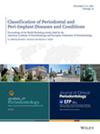Surveying coating strategies for peri-implantitis management: Clinical implications and classificatory approaches.
IF 4.2
2区 医学
Q1 DENTISTRY, ORAL SURGERY & MEDICINE
引用次数: 0
Abstract
BACKGROUND Peri-implantitis, an inflammatory condition occurring in the supportive tissues, is triggered by a dysbiotic biofilm that grows on implant and/or abutment surfaces. Consequently, the entire surface becomes a notorious culprit, fostering bacterial adhesion that might lead to progressive loss of supporting bone. To combat peri-implantitis, research groups worldwide have diligently pursued the development of new antimicrobial coatings. However, for the successful development of coating materials, it is crucial to clarify their intended function. In this review, we propose a clear classification of coating strategies aimed at either preventing or treating peri-implantitis. METHODS We first delve deep within the concepts of prevention and treatment, as well as the physicochemical properties and biological requirements of each dental implant component for interacting with host tissue cells, to unravel and guide materials and technique complexity according to each purpose. RESULTS From a preventive standpoint, the goal is to impede disease initiation. This requires coating materials that can withstand the hostile oral environment indefinitely. In the treatment category, where the disease is already established, the coating material should act directly at the infected site. Furthermore, the physicochemical properties of the new antimicrobial coating must respect the properties required by each part of the implant to not compromise the interaction of the bone-biomaterial and soft tissue-biomaterial interfaces. CONCLUSION Despite considerable efforts in designing antimicrobial coatings, commercial success has remained elusive thus far. This underscores the need to consider essential components to facilitate the construction, validation, and eventual clinical potential of antimicrobial coatings for future marketing. PLAIN LANGUAGE SUMMARY In this review, we have raised an essential point about the importance of considering both biological and chemical challenges in the development of antimicrobial coatings for preventing and treating peri-implantitis. From a preventive perspective, these coatings need to be designed to withstand the complex environment of the oral cavity while maintaining their integrity and functionality. This requires coatings that can resist changes in environmental factors. Conversely, in the treatment category, material coatings need to be responsive to either internal or external stimuli to activate the release of therapeutic agents. These coatings must be capable of switching on or off depending on the intensity of stimuli, allowing for targeted drug delivery to combat infection or inflammation.种植体周围炎处理的涂层策略:临床意义和分类方法。
种植体周围炎是一种发生在支撑组织中的炎症,是由种植体和/或基牙表面生长的生物膜引起的。因此,整个表面成为臭名昭著的罪魁祸首,培养细菌粘连,可能导致支撑骨的逐渐丧失。为了对抗种植体周围炎,世界各地的研究小组一直在努力开发新的抗菌涂层。然而,对于涂层材料的成功开发,明确其预期功能是至关重要的。在这篇综述中,我们提出了一个明确的分类涂层策略,旨在预防或治疗种植体周围炎。方法我们首先深入研究预防和治疗的概念,以及每种种植体成分与宿主组织细胞相互作用的物理化学性质和生物学要求,根据不同的目的揭示和指导材料和技术的复杂性。结果从预防的角度来看,目标是阻止疾病的发生。这就要求涂层材料能够无限期地承受恶劣的口腔环境。在治疗类别中,如果疾病已经确定,涂层材料应直接作用于感染部位。此外,新型抗菌涂层的物理化学性质必须尊重种植体每个部分所需的性质,以不损害骨-生物材料和软组织-生物材料界面的相互作用。结论尽管在抗菌涂层的设计上付出了巨大的努力,但到目前为止,商业上的成功仍然难以实现。这强调了考虑基本成分的必要性,以促进抗菌涂层的构建、验证和最终的临床潜力。在这篇综述中,我们提出了在开发用于预防和治疗种植体周围炎的抗菌涂层时考虑生物和化学挑战的重要性。从预防的角度来看,这些涂层需要设计成能够承受口腔的复杂环境,同时保持其完整性和功能。这就要求涂料能够抵抗环境因素的变化。相反,在治疗类别中,材料涂层需要对内部或外部刺激作出反应,以激活治疗剂的释放。这些涂层必须能够根据刺激的强度打开或关闭,从而允许靶向药物递送以对抗感染或炎症。
本文章由计算机程序翻译,如有差异,请以英文原文为准。
求助全文
约1分钟内获得全文
求助全文
来源期刊

Journal of periodontology
医学-牙科与口腔外科
CiteScore
9.10
自引率
7.00%
发文量
290
审稿时长
3-8 weeks
期刊介绍:
The Journal of Periodontology publishes articles relevant to the science and practice of periodontics and related areas.
 求助内容:
求助内容: 应助结果提醒方式:
应助结果提醒方式:


